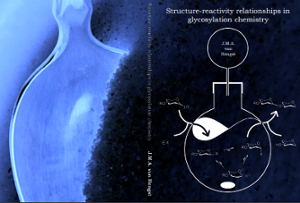Proefschrift
Structure-reactivity relationships in glycosylation chemistry
In a typical glycosylation reaction, a donor is activated to form a (variety of) electrophilic species which can react with a nucleophilic acceptor, following a reaction mechanism having both SN1 and SN2 character.
- Auteur
- J.M.A. van Hengst
- Datum
- 07 december 2023
- Links
- Thesis in Leiden Repository

On the SN1-side of the spectrum oxocarbenium ions partake in the mechanism while covalent intermediates act as the product forming intermediates on the SN2-side. The result of a glycosylation reaction is influenced by the properties of both donor and acceptor and can be affected by external factors as well. Because the challenges in carbohydrate synthesis are typically solved for a specific synthetic problem, a general understanding of what effect changing a single variable has on the mechanistic pathway, and thus the (stereochemical) outcome is not available. This in turn means that synthesis of glycosidic bonds typically requires a considerable amount of optimisation at the expense of a significant amount of time and resources. The goal of this thesis is to systematically investigate how changes in stereochemistry and protecting group patterns on the donor and acceptor affect the mechanism and outcome of glycosylation reactions, to enable a more rational design of synthesis routes.
